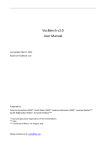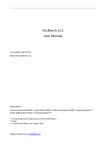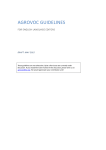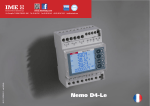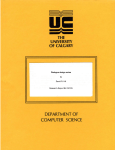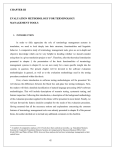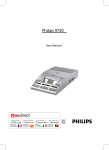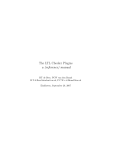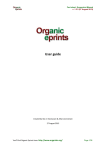Download NeOn template - AIMS - Food and Agriculture Organization of the
Transcript
VocBench v1.3 User Manual Last update October, 2011 Based on VocBench v1.3 Prepared by: Caterina Caracciolo (FAO)*, Gudrun Johannsen (FAO)*, Lavanya Neelam (NIPHM)**, Sachit Rajbhandari (FAO)* * Food and Agriculture Organization of the United Nations. ** National Institute of Plant Health Management, India. Please contact us at: http://aims.fao.org/contact VB 1.1 User Manual Page 1 of 55 Executive Summary This User Manual refers to VocBench (VB) v1.3. It provides a general introduction to VB user interface, functionalities, editorial workflow and operations allowed to Editors and Validators. It does not cover the actions allowed to Publishers and Administrators of VocBench. VB 1.1 User Manual Page 2 of 55 Table of Contents 1 INTRODUCTION ....................................................................................................................................... 6 2 LOGIN........................................................................................................................................................ 7 3 THE USER INTERFACE ......................................................................................................................... 10 3.1 MENU AREA ..................................................................................................................................................... 11 3.1.1 General settings .......................................................................................................................................... 11 3.1.2 Search ............................................................................................................ Error! Bookmark not defined. 3.1.3 Access to content: All modules.................................................................................................................... 12 3.2 CONTENT AREA ................................................................................................................................................ 14 4 PREFERENCES ...................................................................................................................................... 15 4.1 4.2 4.3 4.4 4.5 5 DETAILS (OF USER ACCOUNT) .......................................................................................................................... 15 USER LANGUAGE ............................................................................................................................................. 16 PENDING LANGUAGE REQUEST ......................................................................................................................... 17 USER ONTOLOGY ............................................................................................................................................. 17 PENDING ONTOLOGY REQUESTS ....................................................................................................................... 17 SEARCH .................................................................................................................................................. 18 5.1 SIMPLE SEARCH................................................................................................................................................ 18 5.2 ADVANCED SEARCH ......................................................................................................................................... 20 5.2.1 Search for relationships between concepts ................................................................................................. 20 5.2.2 Search for Term codes ................................................................................................................................ 23 5.2.3 Search for Status ......................................................................................................................................... 23 5.2.4 Search for Classification scheme ................................................................................................................ 24 5.2.5 Search for Concept attribute ....................................................................................................................... 24 5.2.6 Search for Term attribute............................................................................................................................ 25 5.3 CONCEPT NAVIGATION HISTORY ...................................................................................................................... 26 6 USER RIGHTS AND ROLES, ELEMENT STATUS AND WORKFLOW ............................................... 27 6.1 STATUS OF TERMS AND CONCEPTS ................................................................................................................... 27 6.2 USER ROLES ..................................................................................................................................................... 28 6.2.1 Term Editor ................................................................................................................................................. 28 6.2.2 Ontology Editor .......................................................................................................................................... 28 6.2.3 Validators ................................................................................................................................................... 29 6.2.4 Publishers ................................................................................................................................................... 29 6.2.5 Administrators ............................................................................................................................................ 30 7 RECENT CHANGES MODULE .............................................................................................................. 31 8 CONCEPTS MODULE ............................................................................................................................ 33 8.1 THE USER INTERFACE ....................................................................................................................................... 33 8.1.1 Buttons on Concept Hierarchy area [A] ..................................................................................................... 35 8.1.2 Organization of the Concept/Term Area ..................................................................................................... 36 8.2 ADDING A NEW CONCEPT ................................................................................................................................. 39 8.3 DELETING A CONCEPT ...................................................................................................................................... 41 8.4 EDITING THE INFORMATION ATTACHED TO A CONCEPT .................................................................................... 42 8.5 ADDING A DEFINITION TO A CONCEPT .............................................................................................................. 42 8.6 EDIT A DEFINITION OF A CONCEPT .................................................................................................................... 43 8.7 DELETE A DEFINITION OF A CONCEPT ............................................................................................................... 43 8.8 CREATE RELATIONS BETWEEN CONCEPTS ........................................................................................................ 43 9 TERMS .................................................................................................................................................... 48 9.1 9.2 ADDING A NEW TERM ....................................................................................................................................... 48 EDITING OR DELETING A TERM ........................................................................................................................ 49 VB 1.1 User Manual Page 3 of 55 9.3 THE USER INTERFACE ....................................................................................................................................... 50 9.3.1 Tab History ................................................................................................................................................. 50 9.3.2 Tab Relationship ......................................................................................................................................... 50 9.3.3 Tab Attribute ............................................................................................................................................... 51 9.4 EDITING INFORMATION ABOUT A TERM ............................................................................................................ 51 10 10.1 10.2 VALIDATION MODULE ...................................................................................................................... 52 VALIDATION FILTER ......................................................................................................................................... 53 VALIDATION PROCESS ...................................................................................................................................... 54 VB 1.1 User Manual Page 4 of 55 List of Figures Figure 1. Entry Page. ...................................................................................................................... 6 Figure 2. User Login. ...................................................................................................................... 7 Figure 3. User Registration Form. ................................................................................................... 8 Figure 4. Select User Group. Figure 5. Select Language. ................................................... 9 Figure 6. Select Ontology. ............................................................................................................... 9 Figure 7. Registration Confirmation. ................................................................................................ 9 Figure 8. VB User Interface, Concepts Module: Menu area and Content area. ............................. 10 Figure 9. VocBench Interface: Menu area. .................................................................................... 11 Figure 10. General settings: User name [1], User role [2], Data set [3]. ......................................... 11 Figure 11. General settings: Administration, About VocBench, RSS feed. .................................... 12 Figure 12. General settings: Preferences, Help, Sign out. ............................................................. 12 Figure 13. Menu area [B]: Search area. ........................................................................................ 12 Figure 14. Menu area [C]: Access to Content: All Modules. .......................................................... 13 Figure 15. Menu area [C]. ............................................................................................................. 13 Figure 16. Content Language........................................................................................................ 14 Figure 17. Personal Preferences in VB. ........................................................................................ 15 Figure 18. Search Options. ........................................................................................................... 18 Figure 19. Search result with search option „Exact word‟. ............................................................. 19 Figure 20. Search result with search option „Starts with‟. .............................................................. 19 Figure 21. Advanced Search Interface. ......................................................................................... 20 Figure 22. Advanced search: Search by Relationship. .................................................................. 21 Figure 23. Results of Advanced Search: Search by Relationship. ................................................. 21 Figure 24. Advanced Search: Search (preferred terms only) by Relationship AND Word. ............. 22 Figure 25. Results of Advanced Search: Search by Concept AND Relationship. .......................... 22 Figure 26. Advanced Search. Search for Term Codes: Select Repository. ................................... 23 Figure 27. Advanced Search: Search for Term Code. ................................................................... 23 Figure 28. Advanced Search: Search for Status. .......................................................................... 24 Figure 29. Advanced Search: Search for Concept Attribute. ......................................................... 24 Figure 30. Advanced Search: Search for „Fishery related term‟..................................................... 24 Figure 31. Advanced Search: Search for Term Attribute. .............................................................. 25 Figure 32. Advanced Search: Search for „Common name for plants‟. ........................................... 25 Figure 33. Concept Navigation History. ......................................................................................... 26 Figure 34. Legend. ........................................................................................................................ 28 Figure 35. VB Module: Recent Changes. ...................................................................................... 31 Figure 36. Recent Changes Filter. ................................................................................................ 32 VB 1.1 User Manual Page 5 of 55 Figure 37. Concepts Module: Visualizing the Top Concepts of AGROVOC................................... 33 Figure 38. Concept Hierarchy Area [A] and Concept/Term Area [B]. ............................................. 34 Figure 39. Buttons on Concept Hierarchy Area. ............................................................................ 35 Figure 40. Graph Visualization of a Concept. ................................................................................ 36 Figure 41. Concept/Term Area: Information Tabs. ........................................................................ 36 Figure 42. Concept/Term Area: Note. ........................................................................................... 37 Figure 43. Concept/Term Area: Attribute. ...................................................................................... 37 Figure 44. Concept/Term Area: Relationship. ............................................................................... 38 Figure 45. Concept/Term Area: History. ........................................................................................ 38 Figure 46. Concept/Term Area: Hierarchy. .................................................................................... 38 Figure 47. Create a new Concept: Add Term and Language. ....................................................... 40 Figure 48. Create a new Concept: Select „Preferred Term‟. .......................................................... 40 Figure 49. Add new Term to Concept (repeat). ............................................................................. 40 Figure 50. Create new Concept: „Concept already exists‟. ............................................................ 41 Figure 51. Delete Concept: Warning message. ............................................................................. 42 Figure 52. Add Definition............................................................................................................... 43 Figure 53. Create Relation between Concepts: Select Relationship Tab. ...................................... 44 Figure 54. Create new Relation between Concepts. ..................................................................... 44 Figure 55. Relationship Browser. Create new Relation between Concepts. .................................. 45 Figure 56. Concept Browser. Search related Concept. ................................................................. 46 Figure 57. Create new Relation between Concepts: Information added. ....................................... 46 Figure 58. Create new Relation between Concepts: Completed. .................................................. 47 Figure 59. Add / Edit / Delete Term. .............................................................................................. 48 Figure 60. Add new Term.............................................................................................................. 48 Figure 61. Edit Term. .................................................................................................................... 49 Figure 62. Delete Term. ................................................................................................................ 49 Figure 63. Information about a Term: Tab History. ........................................................................ 50 Figure 64. Information about a Term: Tab Relationship................................................................. 50 Figure 65. Information about a Term: Tab Attribute. ...................................................................... 51 Figure 66. Validation Module. ....................................................................................................... 52 Figure 67. Validation Filter. ........................................................................................................... 53 Figure 68. Refresh Validation List. ................................................................................................ 54 VB 1.1 User Manual Page 6 of 55 1 Introduction VocBench1 (VB) is a web-based multilingual vocabulary management tool developed by FAO. It transforms thesauri, authority lists and glossaries into SKOS/RDF concept schemes for use in a linked data environment. VocBench also manages the workflow and editorial processes implied by vocabulary evolution such as user rights/roles, validation and versioning. VocBench supports a growing set of user communities, including the global, distributed group of terminologists who manage AGROVOC2, FAO‟s multilingual agricultural thesaurus. VocBench is optimized to be used within the following browsers: Mozilla Firefox Google Chrome Safari Figure 1. Entry Page. 1 http://aims.fao.org/tools/vocbench-2 2 http://aims.fao.org/standards/agrovoc/about VB 1.1 User Manual Page 7 of 55 2 Login Only registered users may access VocBench. To use VocBench, you have then to login ( Figure 2), by: 1. Registering as a new user by creating an account, 2. Signing in, if you are already a registered user. Figure 2. User Login. 1. Register as a new user and create a new user account: To register as a new user, click on Create an account, and a User Registration form will pop up (Figure 3). Fill in the fields. Note: The fields marked with an asterisk (*) are mandatory. Select the Group(s), i.e. users‟ roles, you would like to register for: Click on the [+] sign, select from the drop down list the appropriate group, and click on Add (see Figure 4). Select the Language(s) in which you wish to manage your data: Click on the [+] sign, select from the drop down list the language(s), and click on Add (see Figure 4). Select the Ontology you would like to manage: Click on the [+] sign, select from the drop down list the ontology you wish to manage, and click on Add (see Figure 6). You may also insert a comment. After clicking on the Save button, a message appears, confirming your registration (see Figure 7). You will receive an email with the Subject title “Welcome to VocBench”, informing you that your registration request was received. You can start using VocBench after approval by the Administrator, and after having received a second email with the Subject title “Activation of your account on VocBench”, containing your registration details. 2. Signing in: If you have already created an account, you may directly log in by entering your user name and password, and clicking on Sign in (Figure 2). VB 1.1 User Manual Page 8 of 55 Figure 3. User Registration Form. VB 1.1 User Manual Figure 4. Select User Group. Figure 6. Select Ontology. Figure 7. Registration Confirmation. Page 9 of 55 Figure 5. Select Language. VB 1.1 User Manual Page 10 of 55 3 The User Interface The user interface for VocBench is currently available in English (default) and Hindi. To switch to the Hindi interface, click on the small drop down box which you find at the top right corner of the entry page, and select Hindi (Figure 1, top left). In the future the interface will also be available in other languages. The VB user interface is organized into two different areas (see Figure 4): 1. Menu area (Figure 8 [Menu] and Figure 9). This area is organized into three horizontal menu bars: o General settings (top menu bar) o Search (central menu bar) o Access to different modules (bottom menu bar) These bars are marked as [A], [B], and [C] respectively, in Figure 8. 2. Content area (Figure 8 [Content]), example: Concepts module A Menu e Content Figure 8. VB User Interface, Concepts Module: Menu area and Content area. B C VB 1.1 User Manual Page 11 of 55 3.1 Menu area A B C Figure 9. VocBench Interface: Menu area. 3.1.1 General settings The top bar in the menu area is dedicated to the following General settings: User name (Figure 10, [1]) o Signed in as: Shows the account name used by the user for login. Role (Figure 10, [2]) o Shows the role (in brackets) played by the user in the workflow, e.g. Publisher, (see Sec. 6). Data set (Figure 10, [3]) o Shows the data set currently in use (e.g. Agrovoc-indexed). To change to another data set, click on arrow and select, e.g. Biotechglossary 1 2 3 Figure 10. General settings: User name [1], User role [2], Data set [3]. Administration (Figure 11, [4]) o Gives access to the list of users and groups registered to VocBench. Note: Only available to Publishers and Administrators. About VocBench (Figure 11, [5]) o Gives access to information about Partners: list of partners collaborating in the development of VocBench. Contact us: Opens a web form to contact VocBench Team by email. RSS feed (Figure 11, [6]) o Allows users to subscribe an RSS feed to be constantly informed about changes in a specific data set (i.e., create/edit/delete concept/terms/relationships), and in user accounts and groups (new user registrations, change of rights). VB 1.1 User Manual Page 12 of 55 5 4 6 Figure 11. General settings: Administration, About VocBench, RSS feed. Preferences [7] (see Figure 12) o Allows users to manage account information, to set preferences regarding user interface and language content (for detailed information, see Sec. 4). Help [8] o Links to this document, published on the FAO website. Sign out [9] o To sign out of VocBench. 7 8 9 Figure 12. General settings: Preferences, Help, Sign out. 3.1.2 Search Search facilities are always available to all users (independently of VocBench module opened) from the central menu bar [B] of the menu area (Figure 13): Simple search o Type in the term or phrase you are looking for (choosing one of the options from the drop down list), and click GO. For detailed description, see Sec. 5.1. Advanced search o Opens an advanced search interface that allows use of more specific search criteria. For detailed description, see Sec. 5.2. Figure 13. Menu area [B]: Search area. 3.1.3 Access to content: All modules The list of VocBench modules available to users, depending on their roles, is shown in the bottom menu bar [C] (Figure 14). VB 1.1 User Manual Page 13 of 55 Please find below a brief introduction to the content of all available modules (see Figure 6), and to the role of users who are allowed to access them. Figure 14. Menu area [C]: Access to Content: All Modules. 1. Recent changes – Access to all users Lists recent changes applied to VocBench such as modifications applied to terms and concepts, user registrations, etc. (for detailed information, see Sec. 7). 2. Concepts – Access to all users Shows concept hierarchy that is browsable as well as detailed information on concepts and terms. This module is used to manage concepts, terms, their relationships, and more (see Sec. 8). 3. Relationships – Access to Publishers and Administrators only Shows all the relationships available for use in the ontology, together with their definitions. This section is used to manage relationships. Actual instances of relations are visualized in the Concepts module. 4. Validation – Access to Validators, Publishers and Administrators Shows all proposed changes applied to the concept schema to be validated. 5. Export – Access to all users To export the concept schema in various formats. 6. Statistics – Access to Ontology editors, Validators, Publishers and Administrators To view information on the amount and type of use on VocBench. Two more buttons, Concept navigation history and Content language, are available in the bottom menu bar [C] of the menu area (see Figure 13, and Figure 15): Figure 15. Menu area [C]. 1. Concept navigation history – Access to all users The navigation history shows the list of concepts navigated during the current session (for detailed information, see Sec. 5.3). 2. Content language – Access to all users To select the languages for display when viewing and searching concepts, relationships, etc., during the current session only (Figure 16). VB 1.1 User Manual Page 14 of 55 Note: To make your language preferences available to future sessions too, use the link Preferences (see Sec. 4). Figure 16. Content Language. 3.2 Content area In the content area of the user interface [Content] (Figure 8), the content displayed depends on the selected module (see Sec. 3.1.3). VB 1.1 User Manual Page 15 of 55 4 Preferences Link Preferences is available from the top menu bar. After clicking on Preferences, five boxes are displayed, showing the following information (Figure 17): Details (of user account) User language (of the data) Pending language request User ontology Pending ontology requestError! Reference source not found.. Note: Preferences will be available in current and future sessions. Figure 17. Personal Preferences in VB. 4.1 Details (of user account) In Preferences users may control personal information: Login o User name. Note: The user name cannot be changed! New password / Confirm password o You may change your password in this field, and o need to confirm your new password. VB 1.1 User Manual Email o Shows your current email address o New email: You may change your email in this field, and o Confirm new email address. Ontology o In case you are an editor of more than one ontology, you can state here the one you want to start with. Landing page in VocBench o Page 16 of 55 To set the VocBench module you want to visualize after logging in. Language of interface o To set the language used for the VocBench interface. Note: Currently the user interface is only available in two languages: English (default) and Hindi. Show URI o Show also non-preferred terms o Corresponds to the check box Show also non-preferred terms available in the Concepts module. Show also non-selected languages o Corresponds to the check box Show URI available in the Concepts module. Generally, concepts in the concept hierarchy are only shown in the user language(s) (see Sec. 4.2). By selecting this option, all terms in all languages are shown, regardless the language(s) for which the users have approval. Hide deprecated terms and concepts o The concept hierarchy will show only concepts and terms with the following status: proposed, validated, published, revised. For detailed information about statuses in VocBench, see Sec. 6.1. 4.2 User Language This part shows the list of languages for managing data for which users already have approval (see Figure 17). In case users want to remove any language(s), they can select the appropriate language(s), and click on the [-] button. If users want to manage concepts/terms in a new language, they have to click on the [+] icon, select from the drop down list the language, and click on Add. After this step, the selected language will be added to Pending language request. The VocBench Administrator will receive an email about the users„ language request. After approval, users will be notified by email. Note: The language of the data may also be selected by using the button Content language (see Sec. 3.1.3). In that case the change will be valid in the current session only. VB 1.1 User Manual Page 17 of 55 4.3 Pending language request This field shows the new language requested by the users, and waiting for the Administrator‟s approval (see Figure 17). After approval it will be removed from this list and moved up to the list of user languages. The users will be notified by email, and then may add, edit, or delete concepts and terms in those languages. 4.4 User ontology This area shows the list of ontologies (or data sets) for which users already have access (see Figure 17). If users want to remove any ontology, they can select the appropriate ontology and click the [-] button. If users want to manage a new ontology, they can click on the [+] icon, select the available ontology, and click on Add. After this step, the selected ontology will be added to Pending ontology request. The VocBench Administrator will receive an email about the user's ontology request. After approval, users will be notified by email. 4.5 Pending ontology requests This part shows the ontology requested by the users, and waiting for the Administrator‟s approval. After approval it will be removed from this list and moved up to the user ontology list. Users will be notified by email, and then will have access to the new ontology. VB 1.1 User Manual Page 18 of 55 5 Search Search functionalities are always available, and to all users. VocBench allows you to perform a simple search and an advanced search. Both are case insensitive. Figure 18. Search Options. 5.1 Simple search Users may choose one of the following search options (Figure 18): 1. Exact word (default) With this option you will retrieve the concepts labelled by terms (in any language) matching exactly the word typed in. Example: Figure 19 shows the results of a search for “palm”, when English is the only language selected. 2. Contains With this option you will retrieve the concepts labelled by terms (in any language) that contain the word (or string) typed in. Example: A search for “palm” returns also the terms “Acer palmatum”, “oil palms”, “ascorbyl palmitate”. 3. Starts with With this option you will retrieve the concepts labelled by terms (in any language) that start with the search string typed in. This search also retrieves composed terms that contain words starting with the string typed in. Example: In Figure 20 you can see the results of a search for “tomato”. 4. Ends with With this option you will retrieve the concepts labelled by terms (in any language) that end with the word typed in. 5. Fuzzy search This option retrieves concepts labelled by terms that are similar to the one you typed in. For example, search terms such as "communicatione" or "communicatio" will give also result for "communication". VB 1.1 User Manual Page 19 of 55 Figure 19. Search result with search option ‘Exact word’. Figure 20. Search result with search option ‘Starts with’. Note: Clicking on Last Results (next to „Advanced search‟), will display the results of your last search. VB 1.1 User Manual Page 20 of 55 5.2 Advanced search Clicking on Advanced search, will display a detailed search form (Figure 21). By default, the search is done across the languages set in Preferences, also shown in Search in these language(s). To change search languages, click on the [+] or [-] icon to add or remove languages. Figure 21. Advanced Search Interface. An advanced search may be performed by using the same search options described in Sec. 5.1 for simple search. Moreover, two more search options are available: 1. Include notes: By selecting this option, also content of editorial notes, scope notes, and definitions is included in the search. 2. Search preferred terms only: Selecting this option, will restrict the search to terms marked as „preferred term‟. In the Advanced search options area, further constraints to the search criteria may be applied. 5.2.1 Search for relationships between concepts You may search for relationships between concepts in two ways: 1. Specifying only the relationship. Click on the Browse button (Figure 22) to open the Relationship browser, select the relationship you want to search for, and click on Submit. To perform the search, click on the Search button. In Error! Reference source not found.14, the relationship Produces was selected in the Relationship browser. The search result consists of all pairs of concepts being linked by that relationship (Figure 23). VB 1.1 User Manual Page 21 of 55 Figure 22. Advanced search: Search by Relationship. Figure 23. Results of Advanced Search: Search by Relationship. VB 1.1 User Manual Page 22 of 55 2. Searching by both relationship AND concept. Select the relationship in the Relationship browser as described above. In the search box type the word you want to search for, and click on the Search button. Figure 24 shows a search for preferred terms only, by word virus AND by relationship Causes. The results are displayed in Figure 25. Figure 24. Advanced Search: Search (preferred terms only) by Relationship AND Word. Figure 25. Results of Advanced Search: Search by Concept AND Relationship. VB 1.1 User Manual Page 23 of 55 5.2.2 Search for Term codes This type of search is useful when you know the term code (in Figure 26 you can see the term codes currently available in AGROVOC), to find the concept to which the term is associated. In order to search for a concept with given term code, select the Repository, e.g. Has AGROVOC term code (Figure 26), then enter the code in the Code search box, e.g. 7698 (Figure 27), and click on Search. Figure 26. Advanced Search. Search for Term Codes: Select Repository. Figure 27. Advanced Search: Search for Term Code. 5.2.3 Search for Status This option allows you to retrieve all terms/concepts in the selected status (for explanation about term/concepts status, see Sec. 6.1). In order to use this search option, select the term/concept status from the drop down list, e.g. Proposed deprecated, (Figure 28), and click on the Search button. VB 1.1 User Manual Page 24 of 55 Figure 28. Advanced Search: Search for Status. 5.2.4 Search for Classification scheme Currently not available. 5.2.5 Search for Concept attribute To search for concepts having a given value for the selected attribute. Use this search option to find for example concepts belonging to a specific subvocabulary of concepts (Figure 29). Click on the [+] icon to open the list , and select the desired concept attribute, e.g. Is part of subvocabulary. Figure 29. Advanced Search: Search for Concept Attribute. Example: Search for Fishery related concepts (Figure 30): After selecting Is part of subvocabulary from the drop down list, a new window opens where to select Fishery related term. Figure 30. Advanced Search: Search for ‘Fishery related term’. VB 1.1 User Manual Page 25 of 55 5.2.6 Search for Term attribute This search option allows you to search for concepts whose terms have a given attribute value. For example, in AGROVOC, you may use this search option to find concepts whose terms belong to a specific subvocabulary of terms (Figure 31). Click on the [+] icon to open the list, and select the desired term attribute, e.g. Has term type. Figure 31. Advanced Search: Search for Term Attribute. Figure 32 shows a search for common names of plants: After selecting Has term type, a new window opens where to select the value common name for plants. Figure 32. Advanced Search: Search for ‘Common name for plants’. VB 1.1 User Manual Page 26 of 55 5.3 Concept navigation history When clicking on the Concept navigation history button (Figure 18), a window opens which displays the list of concepts (depending on the language selection) navigated during the current session, indicating date and time. In the following example (Figure 33), all languages were selected. Figure 33. Concept Navigation History. VB 1.1 User Manual Page 27 of 55 6 User rights and roles, element status and workflow VocBench (VB) implements a formal workflow, where users contributing to a given concept scheme are assigned one (or more) role(s). By assigning elements in the concept scheme a status, the entire editing flow is described as a formal process. This is the key mechanism to allow for distributed and collaborative editing of concept schemes. In the following we first describe statuses of terms and concepts, then we describe the various roles implemented in the VB workflow. People dealing with VB may play different roles in the workflow, e.g., Editor or Validator, and their work is organized into a workflow. In the AGROVOC workflow, terms (concepts, relations) are first suggested as draft, then revised, and finally approved and published. In order to make such a workflow possible, a notion of element (terms, concepts, ...) status is needed (which is based on the notion of rights on actions, which we do not treat in detail now). 6.1 Status of terms and concepts Terms and concepts have a status, corresponding to their status of approval in the workflow. Possible statuses are: 1. 2. 3. 4. 5. 6. Proposed Validated Published Revised Proposed deprecated Deprecated Proposed. A registered user, e.g. Term Editor, has proposed a new concept or term. The term or concept is drafted, and not yet approved. Validated. A validated term or concept has been approved by a Validator. Only after reviewing by a Publisher, it will become published. Published. A validated change has been approved and confirmed by a Publisher. Only published terms and concepts are included in the public version of the schema. Revised. A registered user has made a revision, e.g. changed a term, or a term relationship. Proposed Deprecated. A term or concept gets status „proposed deprecated‟ when a registered user has proposed to remove it. The deletion needs to be approved by a Validator. Deprecated. A term or concept is deprecated when its deletion has been approved by a Validator. The term or concept is approved as outdated. The legend for the status of concepts and terms is always visible at the bottom of the Concepts and Relationships modules (see Figure 34). VB 1.1 User Manual Page 28 of 55 Figure 34. Legend. 6.2 User roles VocBench includes explicit management of workflow. Possible roles in the workflow are the following: 1. 2. 3. 4. 5. Term Editor Ontology Editor Validator Publisher Administrator 6.2.1 Term Editor Term Editors are user of VocBench with the most restricted editing rights. They are usually terminologist by background. Term Editors may access to following modules: Recent changes Concepts module Export module In Concepts module, Term Editors may perform the following actions in their user language(s) only: Add, edit and delete terms Add, edit and delete relationships between terms, and any other piece of information for terms Add, edit, delete concepts Add, edit, and delete relations between concepts, and any other piece of information for All actions performed by a Term Editor get status Proposed, and need to be approved by a Validator. 6.2.2 Ontology Editor Ontology Editors are more experienced terminologists and thesaurus editors, and have all the rights of Term Editors. Ontology Editors have access to the following VB modules: Recent changes Concepts Export Statistics VB 1.1 User Manual Page 29 of 55 In Concepts module, Ontology Editors may perform the following actions in their user language(s) only: Add, edit and delete terms Add, edit and delete relationships between terms, and any other piece of information for terms Add, edit, delete concepts Add, edit, and delete relations between concepts, and any other piece of information for concepts (definitions, notes, attributes, images) All actions performed by an Ontology Editor get status Proposed, and need to be approved by a Validator. 6.2.3 Validators Validators are experts that can check and validate in their respective language(s) the work done by Term Editors and Ontology Editors. Validators have all the rights of Term Editors and Ontology Editors. Validators may access the following modules of VocBench: Recent changes Concepts Validation Export Statistics In Concepts module, Validators may perform all actions also allowed to Term Editors and Ontology Editors. In the Validation module, Validators may accept or reject any actions that have been proposed or done by users. Those items then get status Validated. 6.2.4 Publishers Publishers are those who have total control of the concept schema, and are responsible for publishing the validated entities. Publishers have all the rights of Term Editors, Ontology Editors and Validators. The following further describes publishers' roles and privileges: Publishers have access to the following modules of VocBench: Recent changes Concepts Relationships Validation Export Statistics VB 1.1 User Manual Page 30 of 55 In Concepts module, Publishers may perform all actions allowed to Term Editors, Ontology Editors and Validators, plus the following ones: Move, link and unlink concepts. In Validation module, they may perform the same actions as Validators. Permission on terms and concepts. Can validate changes applied by editors, and confirm changes applied by Validators. In Relationships module, they may create new relationships between terms and concepts. They ultimately approve a validated entry by a Validator, and change its status to Published. They can still reject validated entries, and thus remove them again from the model (in case of new proposals), or reset them to their previous status (in case of edit or proposal to delete). Finally, Publishers have access to the link Administration, from where two menus are available: Users Groups 6.2.5 Administrators Administrators have access to all modules of VocBench, and have overall rights! VB 1.1 User Manual Page 31 of 55 7 Recent Changes Module In this module you will see the list of all recent changes done in VocBench, starting with the most recent ones (Figure 35). For each action taken, you can see in six columns the following information: 1. Concept / Term / Relationship / Users: shows the element(s) that was/were changed. 2. Change: shows the actual change of the element. 3. Old value: shows the previous state of the element. 4. Action: indicates which action was taken. 5. User: shows the user name of the person who performed the action. 6. Date: indicates exact date and time of the action. Figure 35. VB Module: Recent Changes. VB 1.1 User Manual Page 32 of 55 There is an Apply filter option at the top right of the Recent changes module (Figure 35). The following specific filter options (Figure 36), facilitate the search for recent changes: 1. Filter by user: By default all registered users are selected. To modify the selection, uncheck the check box All (at the bottom of the list), and select the user(s) whose actions you want to view. 2. Filter by action: By default all possible actions are selected. To change the selection, uncheck the check box All, and select the actions you want to check. 3. Filter by date: You may choose a specific date or a period when actions were performed, by selecting Today, This Week, This Month, or entering a date From ….. To. To perform the search, click on Submit. Figure 36. Recent Changes Filter. Other ways to be informed about changes: Subscribe to the RSS feed available at the top menu bar (see Sec. 3.1.1). To see individual concept or term changes: Use the History tabs that appear in the Concept/Term area of the Concepts module when you click on a concept (see Sec. 8.1.2) VB 1.1 User Manual Page 33 of 55 8 Concepts module The Concepts module is available to users playing all roles. It is used to: Browse and navigate the hierarchy of concepts See information attached to individual concepts and terms Add/edit/delete concepts and terms. A concept is anything that is relevant to talk to in a given domain. A concept is represented by all terms, preferred and non-preferred, in all languages, to which it is associated. The entire representation of a concept often includes many terms. Both concepts and terms participate in relationships with other concepts and terms. 8.1 The user interface When clicking on Concepts module, the list of top concepts of the concept hierarchy are displayed. In Figure 37, the top concepts are those of AGROVOC in English. Figure 37. Concepts Module: Visualizing the Top Concepts of AGROVOC. VB 1.1 User Manual Page 34 of 55 When clicking on any of the concepts in the concept hierarchy, the screen is organized into two parts, as shown in Figure 38: The entire hierarchy is shown in the left side [A] (Concept Hierarchy Area), while the information relevant to the selected concept is shown in the right side [B] (Concept/Term Area). A B Figure 38. Concept Hierarchy Area [A] and Concept/Term Area [B]. VB 1.1 User Manual Page 35 of 55 8.1.1 Concept Hierarchy area [A] Figure 39. Buttons on Concept Hierarchy Area. Starting from the left, there are a number of buttons with following functionalities (Figure 39): Reload concept o Makes the screen refreshes, and reload the selected concept, or the entire hierarchy if no concept is selected. Add new concept o To add a new concept to the hierarchy. Delete concept o To delete the selected concept. View graph o Opens a new window or tab with a graphical representation of the selected concept and its relations with other concepts (Figure 40). Next to those buttons, there are two check boxes to select what to show in the concept hierarchy (Figure 39): Show URI o Shows the URI of the selected concept. Show also non-preferred terms o Preferred terms are displayed in bold, and non-preferred terms are shown next to them. VB 1.1 User Manual Page 36 of 55 Figure 40. Graph Visualization of a Concept. 8.1.2 Concept/Term Area The Concept/Term area [B] on the right part of the screen, shown in Figure 38, is organized in tabs, where users have access to all pieces of information about a selected concept. Figure 41 shows the associated English terms for the concept genetically modified organisms (AGROVOC), and the different information tabs. Figure 41. Concept/Term Area: Information Tabs. VB 1.1 User Manual Page 37 of 55 The following tabs are available: 1. Tab Terms Shows all terms associated to that concept, in the languages selected. Note: By selecting in Preferences the option Show also non-selected languages (see Sec. 4.1), all terms in all languages are shown, regardless the language(s) for which the users have approval. 2. Tab Definition Shows the definitions available for the selected concept. 3. Tab Note Shows available editorial and scope notes (Figure 42). Figure 42. Concept/Term Area: Note. 4. Tab Attribute Shows available attributes for the selected concept (Figure 43). Figure 43. Concept/Term Area: Attribute. 5. Tab Relationship Shows the relations that hold between the selected concept and other concepts (Figure 44). VB 1.1 User Manual Page 38 of 55 Figure 44. Concept/Term Area: Relationship. 6. Tab History Shows the history of the selected concept (Figure 45): Creation date of concept Date of last update Term status Detailed information on term changes. Figure 45. Concept/Term Area: History. 7. Tab Image Shows an image of the concept. 8. Tab Hierarchy Presents in a compact way the hierarchy line from the selected concept to its top term (Figure 46). Figure 46. Concept/Term Area: Hierarchy. In the following, we highlight some crucial operations that can be performed on concepts. VB 1.1 User Manual Page 39 of 55 8.2 Adding a new concept This action may be performed by all users. To add a new concept, do the following steps: 1. Choose where in the hierarchy to add the new concept. 2. Click on the [+] icon in the bar above the concept hierarchy (see Sec. 8.1.1, and Figure 39), a window opens with title Create a new concept. 3. In the window, add the following pieces of information (Figure 47): a) Term for the concept. b) Select Language from the drop down list, and c) click on the Create button 4. The system checks if the suggested term is already used in VocBench. If the label does not yet exist, a new window opens where you choose (Figure 48): a) If the new term will be a preferred term by checking the box, or not. b) The position in the hierarchy where the concept should be added. The following possibilities are available: i. Child of the selected concept ii. Same level as the selected concept iii. Top level concept 5. Then, click Create, or Cancel to abandon. 6. After clicking Create concept, a new window appears, titled Add new term <label of concept>”. If you want to add more terms, e.g. in other languages, then click on the button Add and Repeat, and repeat steps 3 to 6 (Figure 49). 7. If the concept already exists, a window with the following message appears (Figure 50): “Concept already exists”. In that case, enter a new term, and click on Check availability. Then follow steps 4 to 7. Note: Currently, VocBench does not implement any constraints on the number of preferred terms introduced. So, please be careful! To add more information to the concept, use the tabs in the Concept/Term area (see Sec. 8.1.2). VB 1.1 User Manual Page 40 of 55 Figure 47. Create a new Concept: Add Term and Language. Figure 48. Create a new Concept: Select ‘Preferred Term’. Figure 49. Add new Term to Concept (repeat). VB 1.1 User Manual Page 41 of 55 Figure 50. Create new Concept: ‘Concept already exists’. 8.3 Deleting a concept This action may be performed by Editors, Validators, Publishers and Administrators. 1. Select the concept in the Concept hierarchy. 2. Click on the [-] icon in the bar above the concept hierarchy (see Sec. 8.1.1, Figure 39). 3. A warning message is visualized: “You are about to delete a concept with all its associated terms <…>, all its subconcepts, and all its relations to and from other concepts. Before deleting this concept, please make sure that all its sub-concepts (if any) are deleted or moved under a new parent. Also make sure that all its relations are to be deleted. The new status of the deleted concept will be “proposed deprecated” (Figure 51). 4. Follow the instruction, then when ready, click Delete. VB 1.1 User Manual Page 42 of 55 Figure 51. Delete Concept: Warning message. Note: When a concept is deleted, its status becomes Proposed Deprecated, but its terms in all languages do not change status! 8.4 Editing the information attached to a concept This action may be performed by Term Editors, Ontology Editors, Validators, Publishers and Administrators. To edit any of the pieces of information attached to a concept: 1. Select the concept in the concept hierarchy, and 2. Click on the appropriate tab. In the following sub sections, the most relevant actions on concepts are singled out and explained in details. 8.5 Adding a definition to a concept To provide a definition for a concept, follow these steps: 1. Click on [+] Add definition. 2. A window opens (see Figure 52) in which the following pieces of information should be added: Definition Language: select language from drop down list. Source for the definition. Possible sources are, e.g. Wikipedia. Provide URL for the source. 3. Click Create or Cancel VB 1.1 User Manual Page 43 of 55 Figure 52. Add Definition. 8.6 Edit a definition of a concept It is possible to edit the entire definition, or the source. 1. Click on the Edit icon of the item you want to edit . 2. Revise definition, and submit your changes. 8.7 Delete a definition of a concept 1. Click on the [-] Delete icon next to the item you wish to delete. 2. Delete and confirm. 8.8 Create relations between concepts To create a relation between two concepts, follow these steps: 1. Select the first concept (by browsing or searching). 2. Click on the Relationship tab (Figure 53). 3. Click on [+] Add new relationship. A popup window will appear where you can specify the relationship to use, and select the other concept in the relation (Figure 54). 4. To select a relationship, click on the Browse button, and the Relationship browser will open (Figure 55). To view the complete list of relationship types, click on Expand all at the bottom of the window, and select from the list the appropriate new relationship. VB 1.1 User Manual Page 44 of 55 5. To select the second concept in the relation, click on the Browse button. The Concept browser will open, where you can search and browse for the desired concept (Figure 56). Once the concept is identified, click Submit (or Cancel). 6. Click the Create button to confirm the new relationship (Figure 57). 7. The new relationship is now visible in the Concept/Term Area (Figure 58). Figure 53. Create Relation between Concepts: Select Relationship Tab. Figure 54. Create new Relation between Concepts. VB 1.1 User Manual Page 45 of 55 Figure 55. Relationship Browser. Create new Relation between Concepts. VB 1.1 User Manual Page 46 of 55 Figure 56. Concept Browser. Search related Concept. Figure 57. Create new Relation between Concepts: Information added. VB 1.1 User Manual Figure 58. Create new Relation between Concepts: Completed. Page 47 of 55 VB 1.1 User Manual Page 48 of 55 9 Terms Terms associated to concepts are displayed in the Concept/Term area of the Concept module (see Sec. 8.1, Figure 38). 9.1 Adding a new term 1. To add a new term, click on [+] Add new term (Figure 59) . 2. In the window that opens, add the term, select the language from the drop down list, and decide if the new term is a Preferred term or not (Figure 60). 3. Click Submit or Cancel. Figure 59. Add / Edit / Delete Term. Figure 60. Add new Term. VB 1.1 User Manual Page 49 of 55 9.2 Editing or Deleting a term To edit a term: 1. click on the edit icon next to the term (see Figure 59): 2. In the window (Figure 61) that opens, revise the term, and click Submit (or Cancel). Figure 61. Edit Term. To delete a term: 1. click on the [-] icon next to the term. 2. A window opens showing a warning message (Figure 62). 3. Click on Delete if you are sure to delete the term, or click Cancel. Figure 62. Delete Term. VB 1.1 User Manual Page 50 of 55 9.3 Information about a term When clicking on a term, a new window opens, presenting three tabs containing the information associated to it: 1. History (Figure 63) 2. Relationship (Figure 64) 3. Attributes (Figure 65) Figure 63. Information about a Term: Tab History. 9.3.1 Tab History Information shown in this tab is automatically collected by VocBench. For each term, one can see the following pieces of information: Creation date Last update Status Moreover, a table shows the sequence of changes applied to the term. 9.3.2 Tab Relationship In this tab one can visualize the term-to-term relations that hold for the selected term. Figure 64. Information about a Term: Tab Relationship. VB 1.1 User Manual Page 51 of 55 9.3.3 Tab Attribute In this tab one may see the attributes assigned to the selected term. In Error! Reference source not found.57, attributes for a term in AGROVOC are shown. Figure 65. Information about a Term: Tab Attribute. 9.4 Editing information about a term 1. Click on term, a window opens with the three tabs shown in Figure 63. 2. Click on the tab Relationship or Attributes, to add, edit or delete information. VB 1.1 User Manual Page 52 of 55 10 Validation module The Validation module contains all the changes done by different users which are to be validated. The Validation module is accessible to Validators, Publishers and Administrators only. When entering the Validation module (Figure 66) you will see, in ascending chronological order, the list of all actions to be validated. Figure 66. Validation Module. The table contains in eleven columns the following information/options: 1. Concept / Term / Relationship / Users: shows the element(s) that was/were changed. 2. Change: shows the current value of the element. 3. Old value: shows the previous value of the element. 4. Action: indicates the change action applied to the element. 5. Owner. shows the owner of the element. 6. Modifier: indicates by whom the change was performed. 7. Creation date: shows when the element was created. 8. Modified date: Indicates when the change was applied. 9. Status: shows the current status of the element. VB 1.1 User Manual Page 53 of 55 10. Validate: option to accept or to reject the modification. 11. Note: A comment about the validation action may be entered here. The comment is automatically sent to the author of the change. 10.1 Validation filter You can filter the list of validation actions presented in the Validation table. There is an Apply filter option at the top right of the Validation module (Figure 66). The filter functionality is very useful when there is a long list of issues to be validated. Clicking on Apply filter a window opens, showing the following specific filter options to facilitate the selection for validation (Figure 67): Figure 67. Validation Filter. 1. Filter by user: By default all registered users are selected. To modify the selection, uncheck the check box All (at the bottom of the list), and select the user(s) whose actions you want to validate. 2. Filter by action: By default all possible actions are selected. To change the selection, uncheck the check box All, and select the actions you want to check. 3. Filter by status: By default all term statuses are selected. To modify the selection, uncheck the check box All, and select the actions you want to check. VB 1.1 User Manual Page 54 of 55 4. Filter by date: You may choose a specific date or a period when actions were performed, e.g. selecting Today, This Week, This Month, or enter a date From ….. To. To perform the selection, click on Submit, and a window opens, showing the concepts or terms which according to your selection need to be validated. Note: The concepts/terms for validation can also be directly selected from the table without using the filter option. 10.2 Validation process The following steps are to be followed in the validation process: 1. To validate the changes, in the Validate column click on the check box Accept or Reject of the concept or term you want to validate. Alternatively, select the options Accept all or Reject all (at the bottom of the Validation module). Before validation, the status of the selected element may be Proposed, Revised, or Proposed deprecated, as shown in Figure 58. After validation, the element changes to red colour, and the status will be changed to Validated, Deleted, Deprecated, or Published (in case the validation was done by a Publisher or Administrator). 2. To the right of the Validate column, there is Note field. The validator can enter a comment, for example explaining why a change was rejected. 3. After accepting or rejecting the issues, click on Validate. 4. After each validation the Modifier will be informed by email that his/her changes were accepted or rejected. Note: After each validation the user should refresh the validation list by clicking on the refresh button at the top left of the Validation module (Figure 66 and Figure 68). Figure 68. Refresh Validation List.























































